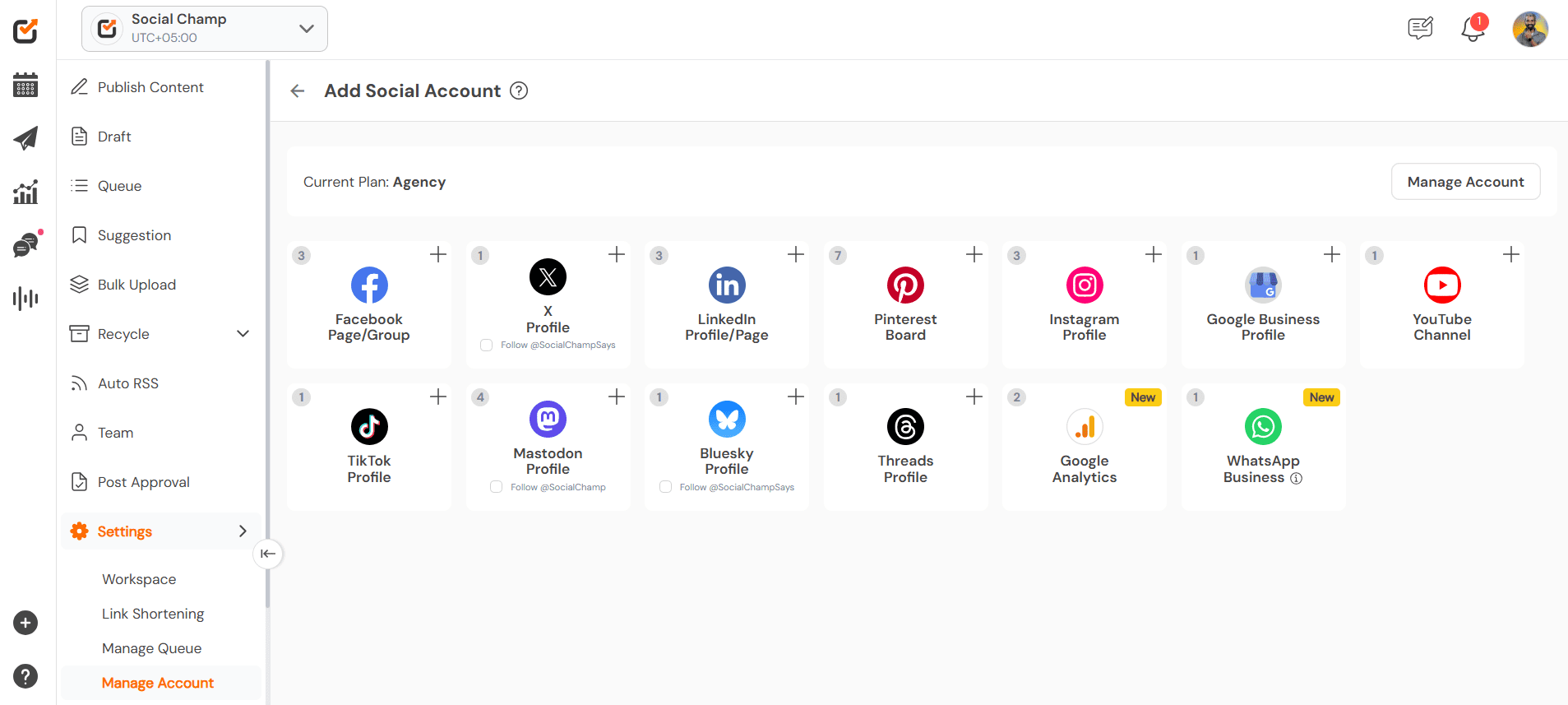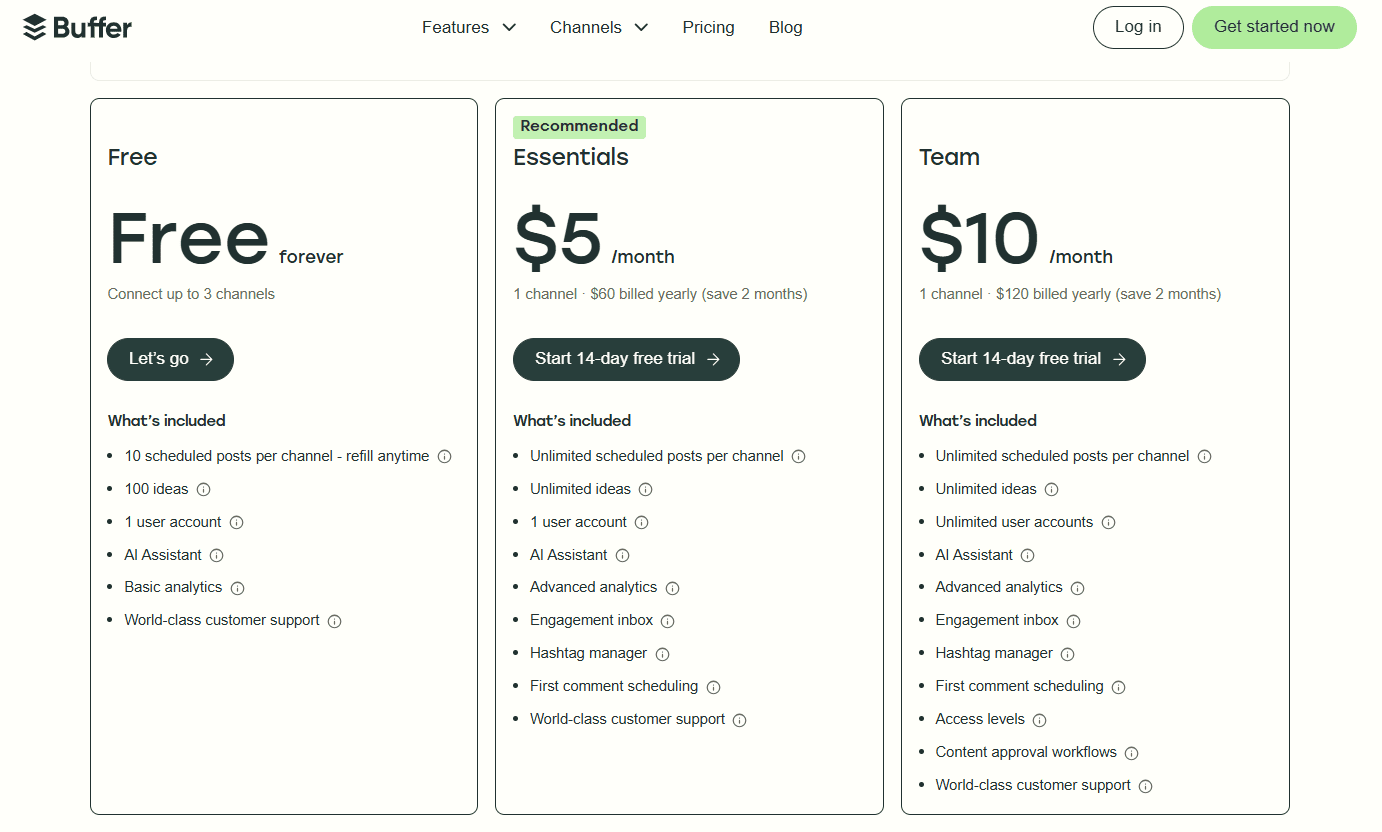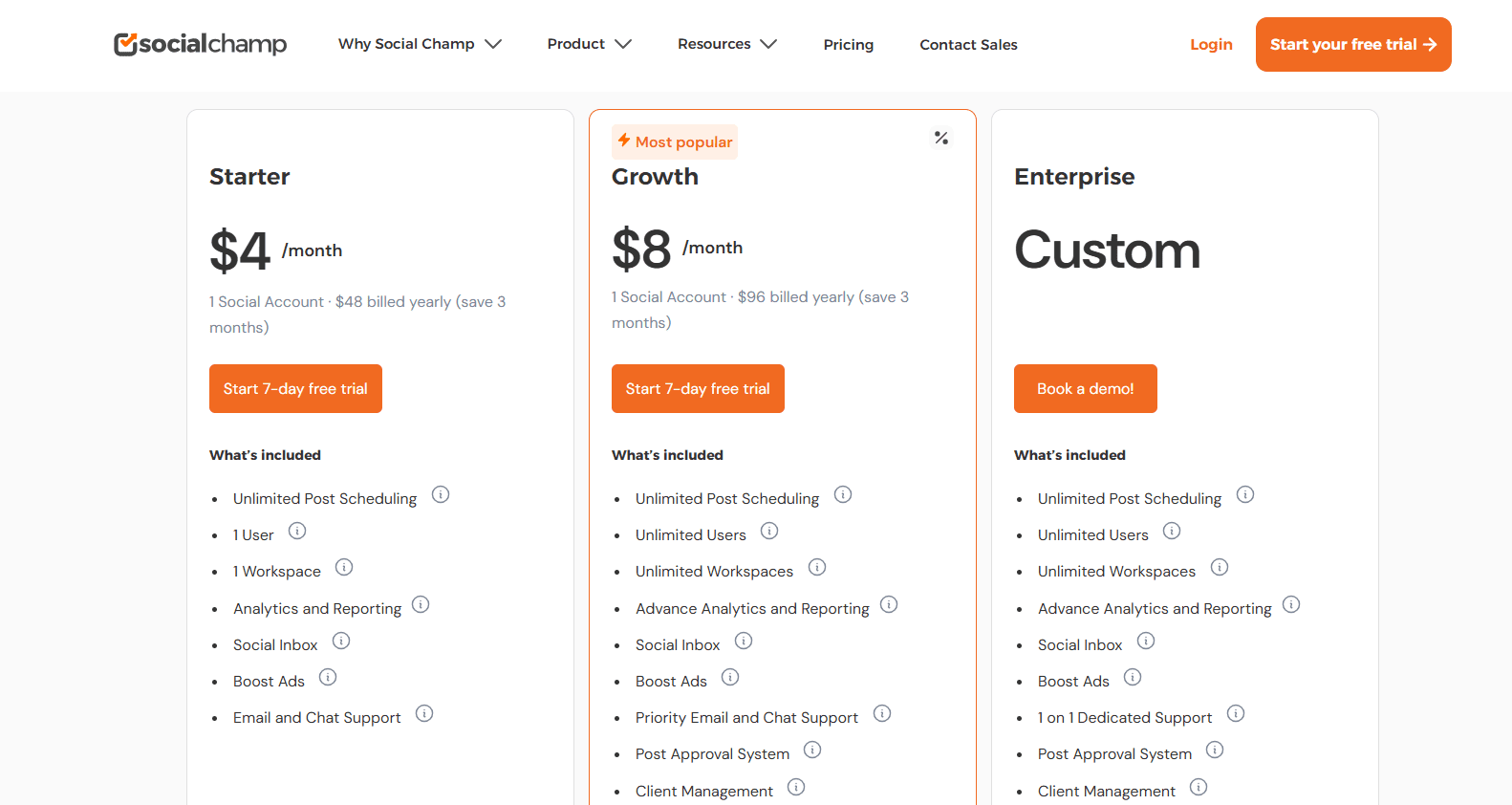Of all the tools available for social media management, Buffer and Social Champ have been two fan favorites, and for good reason.
Both tools have raised the bar with new features, more intelligent automation, and revised pricing strategies, turning the “which one is best?” argument super compelling.
In this post, we’re putting Buffer vs Social Champ head-to-head in the ultimate showdown.
We’ll explore what each tool does best, where they differ, and which one might fit your social media strategy.
Short Summary
- Buffer has a tidy, easy-to-use interface and simple post scheduling, while Social Champ shines with advanced automation features like bulk uploads, content recycling, and RSS posting.
- For analytics, Buffer provides clean, easy-to-read dashboards, while Social Champ includes more intricate, customizable reports, even on its lower-priced plans.
- Social Champ offers support for additional platforms, including Google Analytics 4 and WhatsApp Business, whereas Buffer focuses on the main social networks.
- Pricing-wise, both have free plans, but Social Champ tends to offer more features in the freemium version, so it is a cost-effective solution for growth teams.
- Prior to changing to either tool, you must consider platform compatibility, analytics depth, team needs, automation features, pricing, and ease of migrating content.

Don’t Let Your Posts Miss Prime Time!
Your audience is scrolling right now. Are you there to meet them? With Social Champ’s smart scheduling and automation, your content will never get lost in the noise.
Featured Article: 35 Powerful Social Media Hacks to Take Your Brand to the Next Level
Buffer vs Social Champ: Quick Feature Comparison
Let’s take a look at this quick comparison table before diving headfirst into the details:
| Features | Buffer | Social Champ |
|---|---|---|
| Starting Price | $5/month | $4/month |
| Best For | SMBs, Solopreneurs, and Creators | Agencies, Startups, SMBs, Large enterprises |
| Supported Platforms | Bluesky, Facebook, Google Business Profile, Instagram, LinkedIn, Mastodon, Pinterest, Threads, TikTok, X, and YouTube | Facebook, Instagram, Pinterest, LinkedIn, X, YouTube, TikTok, Threads, Google Business Profile, Mastodon, Bluesky, GA4, and WhatsApp Business |
| User Interface | Simple, Clean, and Straightforward | Simple, Easy to use, and Intuitive |
| Integrations | Canva, Unsplash, Dropbox, Google Drive, OneDrive, Zapier, IFTTT, WordPress, Feedly, Pocket, and Bitly | Zapier, Bitly, Canva, OneDrive, Google Drive, WordPress, Chrome, Dropbox, Imgur, Google Analytics, HubSpot, and Salesforce |
| Publishing and Scheduling | ✅ | ✅ |
| Social Inbox | ✅ | ✅ |
| Boost Post | ❌ | ✅ |
| Analytics | ✅ | ✅ |
| AI Tools | ✅ | ✅ |
| Competitor Analysis | ❌ | ✅ |
| Team Collaboration | ✅ | ✅ |
| Best Time to Post | ✅ | ✅ |
| Social Listening | ❌ | ✅ |
| Link in Bio | ✅ | ✅ |
| Mobile App | ✅ | ✅ |

Last Chance to Master Your Social Game!
Social trends change fast, and your window to ride the wave is closing. Social Champ’s real-time tools ensure you stay ahead of every trend.
Detailed Comparison of Buffer vs Social Champ: Feature-by-Feature
Deciding between Buffer and Social Champ can be challenging, especially since both tools offer a lot.
Both platforms have their upsides, from simple design to dependable automation, and the best one for you will usually rely on your specific requirements.
In the following section, we will cover things feature by feature, so you can get a clear picture of how they compare to one another and determine which one suits your social media objectives.
-
Deep Dive: Analytics, Reporting, and ROI
Analytics are the backbone of any social media plan.
- Buffer has simple analytics dashboards, which display metrics like engagement, impressions, reach, and click-throughs. It also gives you suggestions for when to post based on audience activity. Advanced reporting, however, which includes downloadable PDFs and custom reports, comes only on higher-tier plans.
- Social Champ fills in the gaps with more in-depth reporting capabilities at lower price points. You can create reports that are fully customizable (even white-labeled for agencies) and monitor metrics across platforms. The platform also has very granular data, which is useful when tracking ROI or reporting to clients.

Social Champ’s Analytics
Whereas Buffer analytics are sleek and palatable, Social Champ is more powerful and designed for teams or agencies that require more in-depth insights without the hefty price tag.
-
Platforms, Integrations, and Workflow Automation
A social media app only stands to be as great as the platforms and integrations that it supports.
- Buffer supports the big names: Facebook, Instagram, LinkedIn, Twitter (X), Pinterest, and TikTok. It also provides integrations with Canva, Zapier, and other third-party apps for content creation and automation. Its API-based design supports seamless scheduling across platforms.
- Social Champ covers most of Buffer’s territory but also offers support for networks such as Google Analytics 4 and WhatsApp Business, providing a minor advantage for specialized use cases. Its native automation capabilities, such as RSS feed inclusion and scheduled posting on a repeat basis, are especially beneficial for marketers who wish to “set it and forget it.”

Social Champ’s Supported Platforms
As far as integrations go, Buffer may take the lead in terms of polish and ease of use, but Social Champ gains brownie points for having more automation tools available out of the box.
-
Team Collaboration and Approval Workflows
Both platforms realize that social media is a team sport.
- Buffer makes it possible for teams to work together by allowing roles and permissions. It’s wonderful for small teams that require a basic approval process prior to publishing. Nevertheless, the collaboration options are relatively basic compared to what else is out there.
- Social Champ offers more flexibility for team workflows. Its approval system allows managers to review, edit, and approve content before it goes live. This feature is particularly handy for agencies or larger teams that need multiple rounds of checks.
If you’re running solo or with a small team, Buffer’s system will likely be enough. But if collaboration and approval workflows are key to your process, Social Champ offers more out-of-the-box options.
-
Pricing, Free Plans, and Value for Money
Pricing can be the deciding factor for many users, especially for small businesses or startups.
- Buffer offers a free plan for up to 3 social channels, which is perfect for individuals or small teams just starting out. Its paid plans are tiered based on the number of channels and users, but costs can rise quickly as you scale.

Buffer’s Pricing - Social Champ also offers a free plan but with slightly more generous limits for posting. Its paid plans tend to be more budget-friendly, especially for teams or agencies managing multiple accounts.

Social Champ’s Pricing
When you factor in value for money, Social Champ’s lower pricing and feature-rich plans give it a competitive advantage. However, Buffer’s reputation for reliability and user experience might justify the higher price for some users.
- Buffer offers a free plan for up to 3 social channels, which is perfect for individuals or small teams just starting out. Its paid plans are tiered based on the number of channels and users, but costs can rise quickly as you scale.

The Clock’s Ticking on Social Growth!
Social Champ’s tools aren’t just for scheduling, they’re for accelerating growth. Don’t be the brand still stuck posting manually while others scale effortlessly. Act now!
5 Things You Need to Check Before Switching to Buffer or Social Champ
Before you make the switch from your existing tool to Buffer or Social Champ, you should assess which one works best for you.
Both tools have great features, but your choice should depend on what will suit your team, budget, and process best.
The following are the main things to check:
-
Supported Social Platforms
The initial requirement is to make sure the tool takes care of all the platforms that are essential to your plan.
When you choose a scheduling and publishing tool, the number of platforms it supports is the most important thing to consider.
In this regard, both platforms connect up to 11 social platforms, including Facebook, Instagram, Threads, LinkedIn, TikTok, Pinterest, YouTube, X, Google Business Profile, Mastodon, and Bluesky.
That said, Social Champ also supports WhatsApp Business within its social inbox, which can be great for brands that wish to respond to customers instantly through the platform.
It also connects with Google Analytics 4 to provide you with detailed reports regarding your traffic and sessions.
These two integrations give Social Champ the edge over Buffer.
-
Scheduling Features You Require
When it comes to scheduling, Buffer excels at keeping things simple. In fact, the tool is designed for those who like an uncluttered interface and simple post planning using a visual calendar.
But if you have a high-volume posting or repeat content strategy, Social Champ’s more advanced scheduling features, such as bulk uploads, auto-content recycling, and queue categories, will take you hours of repetitive work.
Ask yourself: Do you only need to schedule posts, or do you require automation that can manage evergreen campaigns and bulk imports?
-
Analytics Depth
Analytics need to be more than just a display of likes and comments; they need to refine your strategy.
Buffer offers easy-to-use analytics dashboards with metrics like engagement, impressions, and audience activity, as well as recommendations for optimal posting times.
But higher-end reporting features (such as custom or downloadable reports) are restricted to premium plans.
Social Champ, on the other hand, provides thorough analytics and reporting capabilities, including the option to create custom reports, even in lower-cost plans.
If ROI or trend tracking is most important to you, Social Champ may be a slightly better option.
-
Team Workflow and Collaboration
Collaboration features can sink or swim team productivity. In this regard, both Social Champ and Buffer have great collaboration features.
These include multi-level approval processes, content drafts, and review functionality, features made for agencies or teams working with multiple clients.
Unfortunately, both platforms limit the collaboration features to the higher-tiered plans.
-
Ease of Migration
Platform switching usually brings the question along with it: “Will I lose all my content?” Neither Buffer nor Social Champ provides direct migration tools, but both make setup convenient. For teams exploring alternatives to Buffer or Social Champ, migration features and onboarding support often become deciding factors.
Social Champ’s bulk content import and upload functionalities are especially convenient for moving large quantities of scheduled content from a different tool. Buffer, as it does not have bulk upload in its free version, still has a pretty decent onboarding process.
Featured Article: Top Free Social Media Scheduling Tools to Boost Your Productivity
Final Verdict: Choosing the Right Tool in 2025
When it comes to comparing Buffer vs Social Champ, both Buffer and Social Champ bring something valuable to the table, and the “better” option really depends on what you’re looking for in a social media management tool.
If you prefer simplicity, a tidy interface, and consistent performance, Buffer is an excellent option. It’s ideal for individuals, small companies, and teams who don’t want to be bogged down by too many features.
Alternatively, if you want stronger automation, more powerful reporting, and more value for your money, Social Champ could be the wiser choice, particularly if you have multiple accounts or operate within an agency environment.
Ultimately, both tools can assist you in streamlining your social media workflow. You can with their free plans, dig through their dashboards, and see which one feels like a glove for your workflow.





